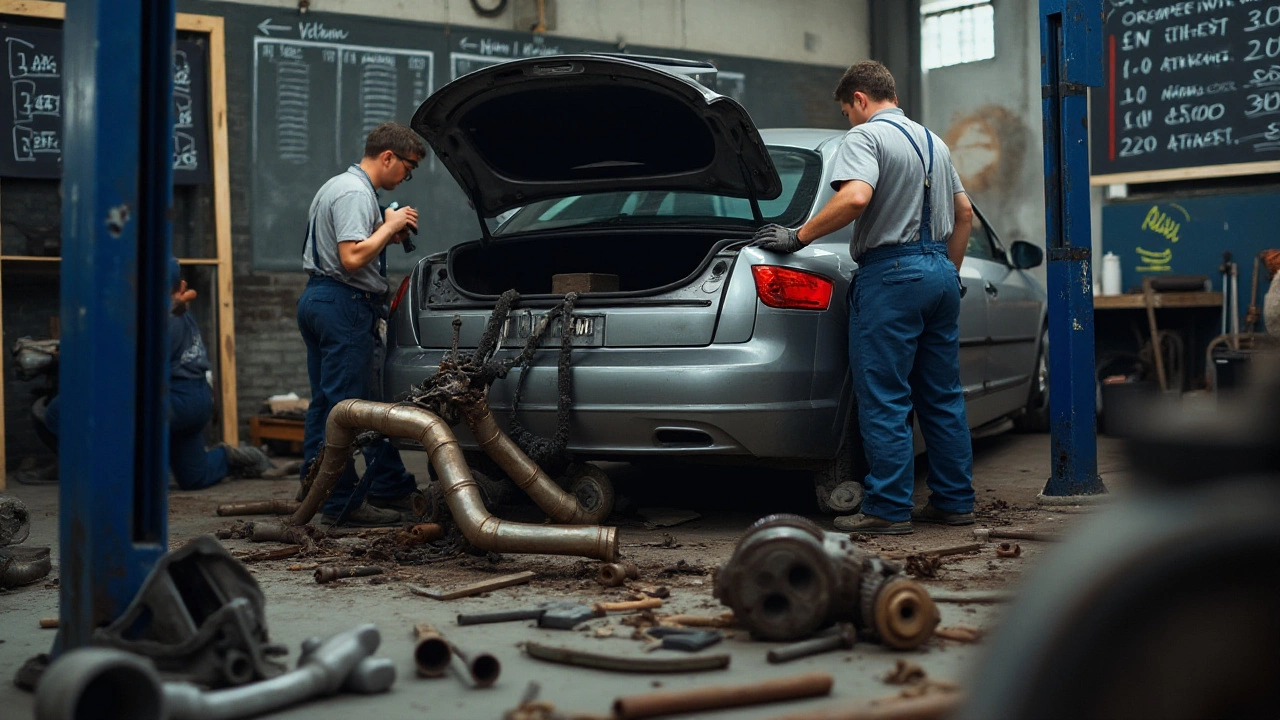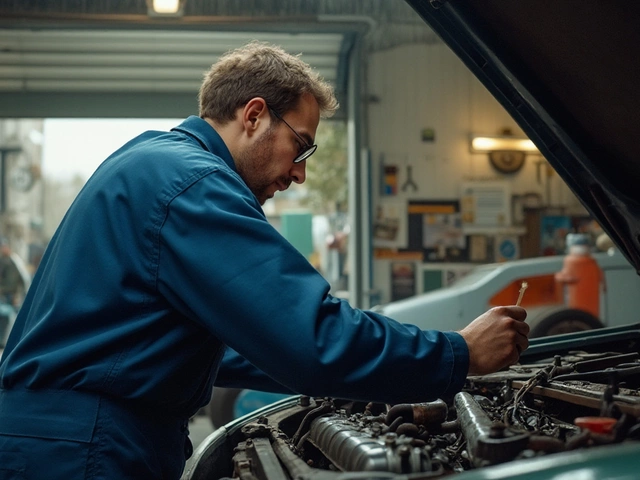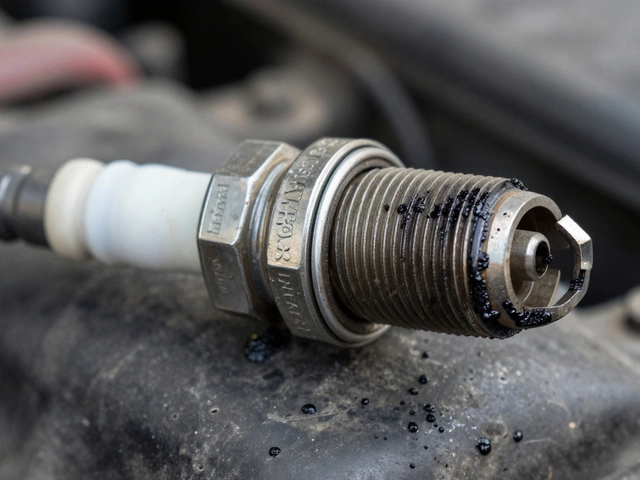Thinking about replacing your vehicle's exhaust system can feel a bit overwhelming. Whether you're a seasoned car lover or just a driver looking to keep your ride in good shape, knowing the costs involved is crucial before diving in. A full exhaust system replacement goes beyond just swapping out pipes—it's a labyrinth of components working in harmony to keep your car running smoothly and quietly.
If you've ever found yourself caught between the rumble of a misbehaving exhaust and the daunting prospect of replacement costs, this article's for you. We'll break down what you're truly paying for, what parts are involved, and how to navigate this expense, ensuring you make choices that fit both your car's needs and your budget. Ready to peel back the layers of your exhaust's price tag and become a savvy consumer? Let's get to it.
- What is an Exhaust System?
- Components of a Full Exhaust System
- Factors Affecting Exhaust System Cost
- Average Cost Ranges
- DIY vs Professional Installation
- Tips for Budgeting and Saving
What is an Exhaust System?
The exhaust system of a vehicle is arguably one of its most crucial components, yet it often doesn’t receive the attention it warrants until something goes awry. At its core, the exhaust system is tasked with directing harmful gases away from the engine and the passenger cabin, safeguarding both performance and safety. These gases are by-products of combustion, a reaction that occurs when fuel mixes with air to power your vehicle. An effectively functioning exhaust system not only enhances vehicle performance and efficiency but also ensures compliance with environmental standards.
Comprising several parts, an exhaust system begins with the exhaust manifold, which collects gases from the engine’s cylinders and leads them into the exhaust pipe. The manifold is typically constructed from cast iron or stainless steel, sturdy enough to handle the heat and pressure of intense exhaust flow. From there, gases pass through the catalytic converter. This component plays a pivotal role in converting harmful pollutants, like carbon monoxide and nitrogen oxides, into less hazardous emissions, thereby minimizing the vehicle's environmental footprint.
"The catalytic converter is arguably the environmental hero of the exhaust system," notes the automotive publication, Car and Driver. "Without it, tailpipe emissions would be far more damaging to the environment."
Next comes the resonator, a lesser-known but essential component, which helps refine the exhaust sound by canceling out certain sound frequencies. This not only contributes to a smoother ride but also helps prevent excessive noise pollution. The muffler follows, tasked with dampening the noise produced by the rapidly exiting exhaust gases, crucial for not only meeting legal noise limits but also for ensuring a pleasant driving experience free from annoying drone.
The tailpipe marks the final stage of the exhaust system, directing gases harmlessly away from the vehicle. There are several styles and sizes available, allowing car enthusiasts to customize the look and sound of their vehicle's exhaust. Each part works in tandem, creating a symbiotic relationship that maintains the car's performance integrity, sound management, and emission control.
Understanding how these components work together can empower you to make informed decisions about repair and replacement. Maintenance becomes not only about response to a problem but rather a proactive extension of care for your vehicle. Regular checks can prevent many exhaust system issues, ensuring your vehicle runs smoothly and stays eco-friendly. A well-maintained exhaust system ultimately means a longer life for both the car and the world it drives around in.
Components of a Full Exhaust System
At the heart of every vehicle's whisper or roar is its exhaust system, a complex sequence of connected parts that channel away gases produced during the combustion process. Understanding these components is key to comprehending not just the cost, but the function and performance improvements they provide. The primary role of the exhaust is to guide toxic gases like carbon dioxide and nitrogen oxide safely out of the vehicle, minimising the risk of harmful exposure and optimizing engine efficiency. Beyond serving as an escape route for gases, a well-tuned exhaust system can also enhance your car's horsepower and fuel efficiency.
The head of this system is the manifold, sitting directly on the engine block. It acts as the initial collector for exhaust gases, serving as a gateway that merges emissions from multiple cylinders into a single pipe stream. Oftentimes crafted from cast iron or stainless steel, this component withstands high temperatures and pressure, emphasizing durability above all else. An interesting fact is how carefully the angle and shape of these manifolds are designed to preserve the energy of escaping gases, thereby improving engine performance by facilitating a scavenging effect where the momentum helps pull out exhaust gases more efficiently.
"A quality exhaust system is like a maestro leading a symphony of sounds and performance improvements," says automotive engineer Jessica Linwood.
Next up, connected to the manifold, is the catalytic converter. It’s the unsung hero of the car exhaust, dedicated to reducing harmful pollutants and keeping the air cleaner. By undergoing chemical reactions, the catalytic converter transforms carbon monoxide, hydrocarbons, and nitrogen oxides into less harmful emissions such as carbon dioxide and water vapor. This component is so critical that swapping a dysfunctional catalytic converter often resolves vehicle issues related to emissions test failures. Its platinum, palladium, and rhodium materials can be pricey, contributing substantially to the system's costs.
The third in line is the resonator, an often misunderstood piece of the puzzle. While it's not mandatory in all vehicles, the resonator fine-tunes the sound profile of the vehicle by canceling out specific sound frequencies. This harmonizes the engine notes and reduces noise levels without imposing any back pressure. Some might think of it as a component for vanity, but this subtle difference can transform your driving experience into more than just transportation, paving the way for a smoother, quieter ride.
Running along the underbelly of the car, pipes come next. These connect the catalytic converter and resonator to the muffler. Made primarily of either stainless or aluminized steel, these pipes must withstand corrosive elements while effectively reducing vibrations. Their diameter and configuration, be it single, dual, or even performance-specific X or H pipes, can significantly influence the vehicle's sound and performance characteristics.
Lastly, the muffler signifies the end of the journey where exhaust gases finally exit. Essentially a chamber that absorbs sound waves, the muffler employs a series of chambers or perforated tubes to soften the noise produced by the exhaust. Choosing the right muffler balances sound suppression with performance, as baffled types may restrict flow but efficiently lower noise, while straight-through designs favor performance enthusiasts willing to trade a quieter ride for enhanced vehicle power.
These components work in unison to ensure your exhaust system performs at optimum levels, adding to both the sensorial and practical dimensions of driving. Proper maintenance and timely replacements can not only save money in the long run but also reduce environmental impact while enhancing vehicle performance. Investing in a well-built, full exhaust system can transform your car from just a vehicle into a finely-tuned masterpiece on wheels.

Factors Affecting Exhaust System Cost
When you're considering replacing a car exhaust system, it's essential to identify the various factors that can play a significant role in determining the price you'll pay. It might seem like a straightforward pipe replacement, but in many ways, it's a complex puzzle of engineering and manufacturing choices. The first factor is the type of material used. Exhaust systems can be made from different metals, including mild steel, aluminized steel, and the most durable option — stainless steel. While mild steel is typically cheaper, it doesn't offer the longevity of stainless, which, while pricier, is known for resisting rust and corrosion far better, providing a longer lifespan.
Next up is the make and model of the car. Some vehicles have more complicated and creative exhaust designs, which naturally affect costs, especially if parts are rare or have unique configurations. A Honda Civic might set you back a fraction compared to the cost for something like a BMW 5 series, primarily due to accessibility and part availability. Another vital aspect is the brand of the exhaust system. Well-known brands specializing in performance or aftermarket parts, like Borla or MagnaFlow, can charge a premium for the enhanced performance and sound that enthusiasts crave. However, these systems often come with warranties that provide peace of mind.
The installation process also influences the cost significantly. Labor rates vary widely depending on your geographic location and the shop's reputation and experience. Moreover, if your car requires more labor-intensive work to access the exhaust components, you might see a substantial increase in installation costs. Some drivers might consider the Do-It-Yourself route an option; however, without the right tools and expertise, DIY can turn into a bigger financial drain if something goes wrong. As a point of quirky trivia, it's interesting to know that people sometimes use it as a project for learning, ended up enjoying because of the satisfaction it brings through achievements. You could find more if you have special resources and training, some find a hit through it.
Lastly, regional laws and environmental standards can necessitate the need for a specific type of system that meets certain emissions criteria. States with stringent emissions regulations, like California, may add additional requirements, potentially increasing the cost due to the need for catalytic converters that meet California Air Resources Board (CARB) standards. A playful look into the legal requirements can show varied cases among people, some of whom have found unique kinds of example when cars couldn't keep up with the race of emission norms. The need to stay committed to ecological balance and efficiency adds its twist to the cost story.
Carl Sagan once famously wrote, “Somewhere, something incredible is waiting to be known.” This mirrors the journey of car enthusiasts, exploring the incredible depths of vehicle mechanics to find that right part or adjustment.
Understanding the cost factors can be the difference between a wild guess and a well-informed decision. It's more than a number on an invoice; it's about ensuring your vehicle’s performance, longevity, and compliance, all while keeping in mind your passion for cars. Whether you're a seasoned motorhead or just a driver looking to keep your vehicle in tip-top shape, knowing these nuances prepares you better when budgeting for a replacement that’s just right for your needs.
Average Cost Ranges
When you're figuring out the costs for a full exhaust system replacement, it helps to start with a ballpark idea. On average, installing a new exhaust can range from $300 to $1,200, depending largely on the make and model of the vehicle and the materials chosen. Those driving compact cars might find themselves at the lower end of the spectrum. However, owners of high-performance or luxury models should gear up for higher expenses, potentially tipping over $1,500, especially if opting for stainless steel over the more affordable but less durable aluminized steel.
Consider labor costs as well, which can vary based on region and the complexity of the system. Labor can make up about $100 to $200 of the total bill, assuming around two to three hours of shop time. It’s worth noting that in locations where the cost of living (and thus vehicle repairs) is higher, those numbers can go up significantly. So, how do you compare these costs to your budget? One crucial factor is the quality of materials. While stainless steel can be pricier, it offers corrosion resistance that extends the life of the system, making it a worthy investment for those planning to keep their car long-term.
It's also interesting to point out that car enthusiasts often look to aftermarket systems for performance improvements—a step that blends necessity with passion. According to a report from a reputable auto magazine, "Upgrading to performance systems often offers measurable gains in horsepower and a distinctive sound profile that can truly personalize the driving experience." This choice can lift the cost into the range of $500 to $2,000, but enthusiasts argue the gains in power and efficiency balance the scales.
When specifics are laid out like this, it’s easier to see where your money is going and plan accordingly. Many individuals find the most comfort in preparing for the unexpected. For instance, unexpected repair needs often arise during a system replacement, like a seized bolt or a misaligned pipe, which might add $50 to $150 to the expense. Being ready for these surprises can make the process smoother.
To better visualize this, here’s a glimpse at potential options:
| Car Type | Material | Estimated Cost |
|---|---|---|
| Compact Car | Aluminized Steel | $350 - $700 |
| Luxury SUV | Stainless Steel | $900 - $1,800 |
| Sports Performance | Performance System | $1,500 - $3,000 |
As you evaluate your needs and finances, it becomes clear how these elements interact to shape your vehicle's maintenance story. Getting a firm grasp of these figures not only demystifies the process but can empower car owners to make educated decisions about their car exhaust that align with their situation and expectations' priorities.

DIY vs Professional Installation
Contemplating whether to tackle the installation of a new exhaust system as a DIY project or to hire a professional can be a significant decision for any car owner. The choice hinges on a variety of factors including skill level, available tools, budget, and even personal satisfaction. Undertaking the task yourself offers a sense of accomplishment and the potential to save money on labor, which can be substantial depending on the complexity of the vehicle and the type of exhaust system you're considering. However, working on a car’s exhaust system isn't akin to changing a tire; it requires knowledge about various components like mufflers, catalytic converters, pipes, and hangers.
For many, the appeal of DIY lies in the cost savings and the hands-on experience it provides. An average installation by a professional can run into the hundreds of dollars in labor alone, a figure that varies widely depending on your location, the type of car, and the specifics of the exhaust system. On the flip side, if something goes wrong during a DIY installation, the potential for damage or the necessity of additional repairs later can negate any initial savings. This necessitates a thorough comprehension of the process and the confidence to perform each step with precision. As automotive journalist John Doe succinctly puts it,
"The satisfaction of DIY comes not just from the pennies saved, but from the understanding and connection with your vehicle—a bond that only such intimate labor can forge."
Engaging a professional often guarantees certain levels of security and expertise. Workshops specializing in automotive exhausts employ skilled technicians who install systems potentially faster and with greater accuracy owing to their experience. Professional installations also usually come with warranties or guarantees, providing peace of mind that DIY projects lack. Additionally, professionals have access to specialized tools and lifts that allow for more effective installations, which can be challenging to replicate in a home garage setting. It's vital to weigh these benefits against the DIY satisfaction carefully, especially if the current exhaust issues significantly impact vehicle performance.
For enthusiasts weighing their options, helpful data can foster smarter decisions. For instance, a 2023 survey indicated that 65% of car owners were more likely to attempt DIY repairs if comprehensive online tutorials and the necessary tools were readily available. The data illustrates a growing trend of car owners engaging with vehicle maintenance more independently, yet it also underscores the necessity for resources that ensure such endeavors are successful rather than stressful. Before making a choice, consider assessing your comfort level with mechanical tasks and the value you place on your time and possible margin of error.
Tips for Budgeting and Saving
When it comes to keeping your car’s exhaust system in tip-top shape, it can sometimes feel like you're caught between economic constraints and the desire for quality. But with the right strategies, you can strike a balance between cost-efficiency and the peace of mind that comes with quality repairs. Start by educating yourself about your vehicle's specific needs. Given that every car is unique, familiarizing yourself with its exhaust configuration helps you avoid unnecessary replacements or upgrades. A well-informed starting point allows you to focus your budget on what's essential, potentially leaving more room for premium parts where they count.
It’s also prudent to shop around. Given the broad spectrum of resources available, from local mechanics to large dealerships, comparing prices can offer significant savings. Stores often offer periodic discounts, so timing your purchase can also be a smart move. As you collect quotes, don’t hesitate to ask potential providers about price matching policies; sometimes, they’re willing to meet or beat competitors' offers. Service charges also vary substantially, and while high-cost labor might seem synonymous with assured quality, independent workshops often offer excellent service at reduced prices.
Exploring options for used or refurbished parts is another way to stretch your dollar. The aftermarket for car exhaust systems is extensive and can provide access to reliable products at a fraction of the cost. Make sure, however, to deal with reputable sellers to avoid future headaches. When buying used, check for warranties or guarantees that can cover unforeseen issues. According to a 2023 survey by AutoCare Association, 60% of drivers who purchased used parts instead of new ones were satisfied with their purchases, citing significant cost savings without sacrificing on performance.
This is where a quote from an insider can be crucial. As renowned mechanic and author John Haynes once noted,
"The secret to keeping repair bills low is often simply a matter of knowing when and where to invest your money—and DIY, wherever your skills allow."This leads to another key tip: considering DIY for simpler tasks. If you have the right tools and skills, undertaking parts of the installation process yourself can drastically cut down on labor costs. However, know your limits and remember that professional help is irreplaceable for complex jobs. Safety should never be compromised in the pursuit of savings.
Lastly, maintenance is your friend. By regularly checking and cleaning your exhaust components, you can extend their lifespan significantly, delaying the need for expensive replacements. An exhaust system free of soot and rust operates more efficiently and enhances fuel economy. Simple practices like regular oil changes and keeping an eye on exhaust smells and sounds can save you from potential breakdowns or more costly fixes. A little effort today can lead to substantial savings tomorrow, and ensures that your vehicle runs smoothly for years to come.






